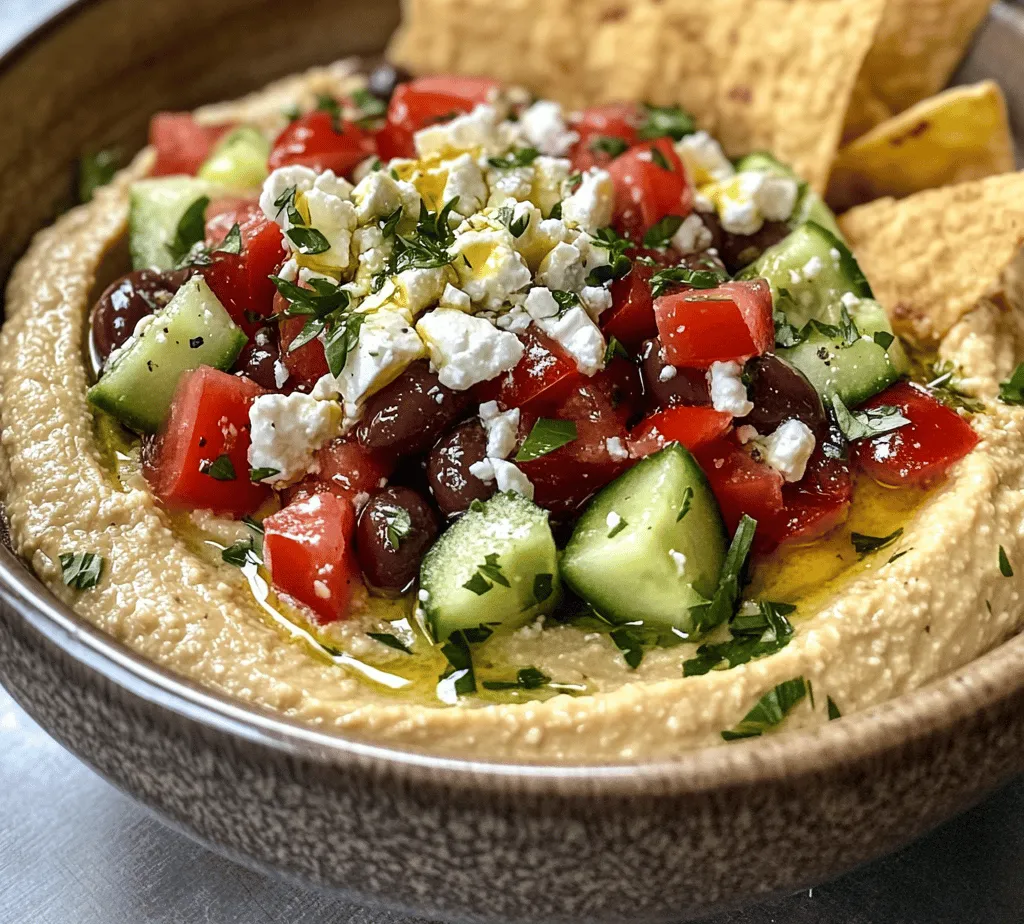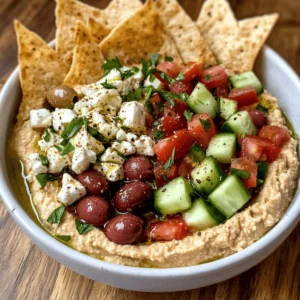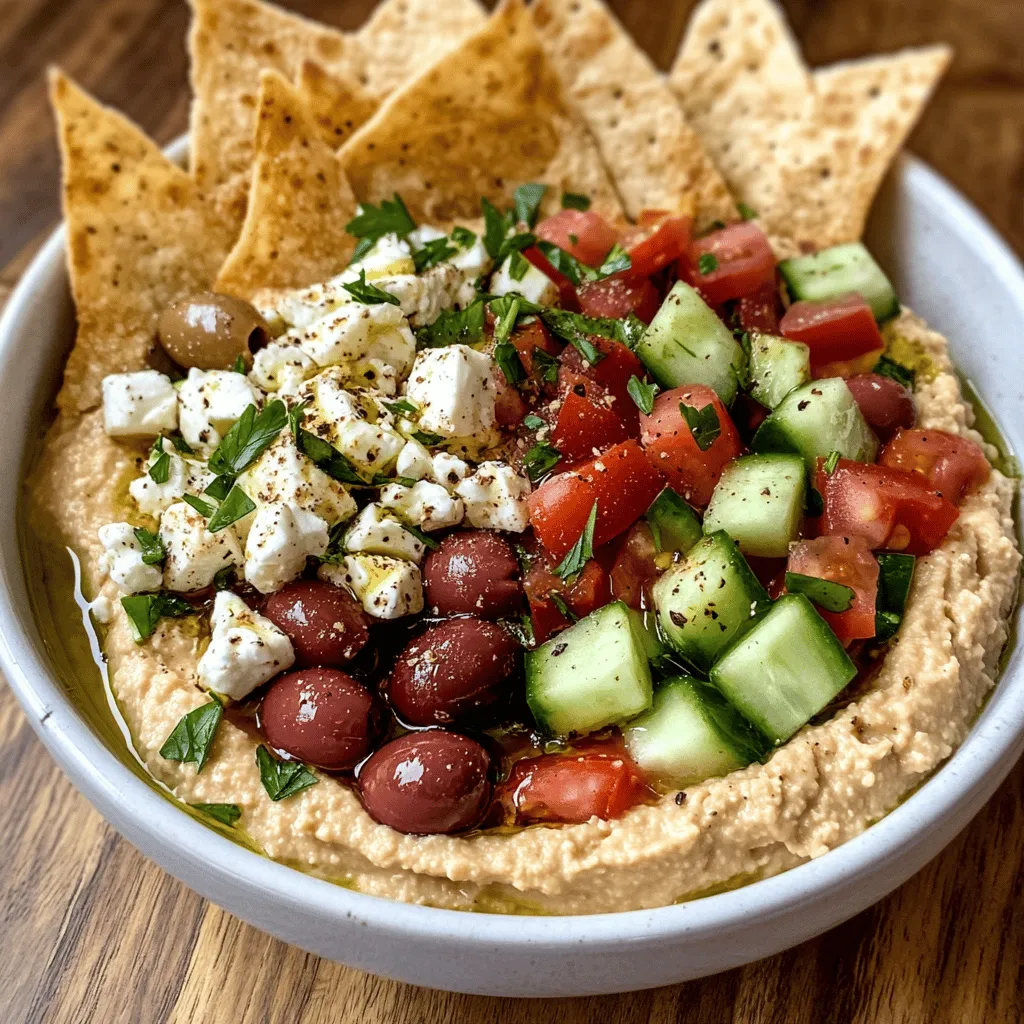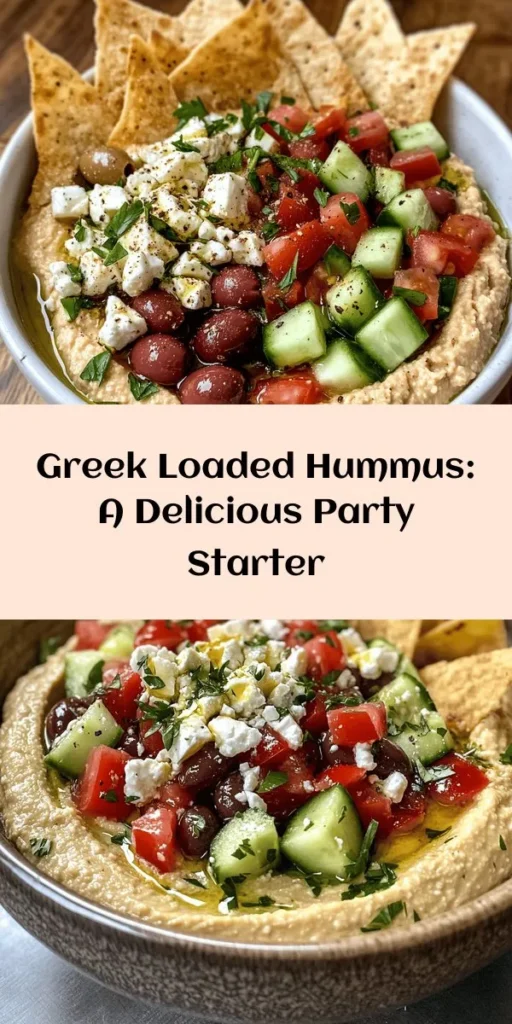Introduction to Greek Style Loaded Hummus
Hummus, a creamy dip made primarily from chickpeas, has become a staple in Mediterranean cuisine and is cherished worldwide for its rich flavor and versatility. Traditionally, hummus is crafted from simple ingredients, resulting in a smooth, velvety spread that pairs beautifully with various dishes. It embodies the essence of the Mediterranean diet, which emphasizes wholesome, fresh ingredients that not only tantalize the taste buds but also promote health and well-being.
The Greek Style Loaded Hummus takes this beloved dish to new heights, offering a delightful twist by incorporating traditional Greek toppings that enhance both flavor and nutrition. By combining the classic base of hummus with vibrant and fresh ingredients, this version becomes an exciting centerpiece for any gathering, a delicious snack, or a wholesome appetizer.
This dish is not only visually appealing but also brimming with health benefits. The ingredients used in Greek Style Loaded Hummus are packed with nutrients, making it an excellent choice for those seeking a healthy and satisfying option. Chickpeas, the primary ingredient, are rich in protein and fiber, which aid in digestion and contribute to overall health. The addition of Greek yogurt provides probiotics, further enhancing its nutritional profile and promoting gut health.
Beyond its health benefits, hummus is incredibly versatile. It can be enjoyed as a dip with pita chips or veggie sticks, spread onto sandwiches, or used as a topping for salads and grain bowls. Its adaptability makes it a go-to option for parties, family gatherings, or casual snacking at home. Now, let’s delve deeper into the ingredients that make up this delicious Greek Style Loaded Hummus.
Understanding the Ingredients for Greek Style Loaded Hummus
Chickpeas: The Heart of Hummus
Chickpeas, also known as garbanzo beans, serve as the foundational ingredient in hummus. Not only do they lend a creamy texture and nutty flavor, but they also boast an impressive nutritional profile. Chickpeas are an excellent source of plant-based protein, making them an ideal option for vegetarians and vegans. One cup of cooked chickpeas contains approximately 15 grams of protein and 12 grams of dietary fiber, which can help keep you feeling fuller for longer.
Additionally, chickpeas are rich in essential vitamins and minerals, including folate, iron, and magnesium. These nutrients play a crucial role in maintaining energy levels and supporting overall health. Furthermore, their low glycemic index means they can help regulate blood sugar levels, making hummus a smart choice for those managing diabetes or looking to maintain stable energy throughout the day.
Tahini: The Creamy Element
Tahini, a paste made from ground sesame seeds, is another essential ingredient that contributes to the rich, creamy texture of hummus. This ingredient not only enhances the mouthfeel of the dip but also adds a distinct nutty flavor that complements the chickpeas beautifully.
From a nutritional standpoint, tahini is a powerhouse. It is packed with healthy fats, particularly monounsaturated and polyunsaturated fats, which are known to support heart health. Additionally, tahini is a good source of calcium, which is vital for bone health, and contains various antioxidants that can help protect the body from oxidative stress. Its creamy texture is crucial in achieving the desired smoothness of the hummus, and it ties all the flavors together seamlessly.
Olive Oil: Flavor and Texture
No Mediterranean dish is complete without a drizzle of good quality olive oil. In Greek Style Loaded Hummus, olive oil serves multiple purposes: it enhances the flavor, adds richness, and contributes to the overall texture of the hummus.
Olive oil is renowned for its health benefits, particularly its high content of monounsaturated fats and antioxidants. Regular consumption of olive oil has been linked to a reduced risk of heart disease and improved cholesterol levels. Furthermore, its anti-inflammatory properties can help combat various health issues. When using olive oil in your hummus, opt for extra virgin olive oil for the best flavor and health benefits.
Lemon Juice: A Touch of Brightness
Lemon juice is an essential component of hummus, as it adds a bright, tangy flavor that balances the creaminess of the tahini and chickpeas. The acidity of lemon juice enhances the overall flavor profile of the dish, making it more vibrant and refreshing.
From a nutritional perspective, lemon juice is an excellent source of vitamin C, which is crucial for immune function and skin health. It also aids in digestion and can help detoxify the body. The inclusion of lemon juice in Greek Style Loaded Hummus not only brightens the dish but also adds a layer of health benefits.
Garlic and Ground Cumin: Flavor Enhancers
Garlic and ground cumin are two ingredients that bring depth and warmth to Greek Style Loaded Hummus. Garlic adds a pungent, aromatic quality that elevates the overall flavor and provides numerous health benefits. It is known for its antibacterial and antiviral properties, and it may help lower blood pressure and cholesterol levels.
Ground cumin, on the other hand, imparts a warm, earthy flavor that complements the other ingredients beautifully. Cumin is packed with antioxidants and has been associated with various health benefits, including improved digestion and enhanced immune function. Together, garlic and cumin create a flavorful base that distinguishes Greek Style Loaded Hummus from traditional versions.
Toppings: A Greek Twist
What sets Greek Style Loaded Hummus apart from its traditional counterpart is the array of delicious toppings that are added to the hummus base. These toppings not only enhance the visual appeal but also contribute to the flavor and nutritional value of the dish.
– Greek Yogurt: Adding a dollop of Greek yogurt on top of the hummus provides a creamy texture and a tangy flavor, while also boosting the protein content. Greek yogurt is rich in probiotics, which promote gut health and aid digestion.
– Cucumber: Fresh cucumber adds a refreshing, crunchy element to the dish. It is low in calories and high in water content, making it a hydrating choice. Cucumber also provides vitamins K and C, along with various antioxidants.
– Tomatoes: Chopped tomatoes bring a burst of juiciness and color to the hummus. They are rich in vitamins A and C, as well as lycopene, an antioxidant known for its health benefits, including heart health and cancer prevention.
– Kalamata Olives: These dark, briny olives add a salty, savory flavor that perfectly contrasts the creaminess of the hummus. Olives are high in healthy fats and antioxidants, making them a nutritious addition.
– Feta Cheese: Crumbled feta cheese adds a tangy, salty flavor that enhances the overall taste of the dish. Feta is lower in calories compared to other cheeses and offers a good source of protein and calcium.
Serving Options: Perfect Pairings
Greek Style Loaded Hummus is incredibly versatile, making it easy to serve in various ways. Traditionally, it is enjoyed with pita chips or fresh veggie sticks, such as carrots, celery, and bell peppers. These pairings not only add crunch and texture but also provide additional nutrients.
For a more substantial meal, consider serving the hummus as a spread on sandwiches or wraps, or as a topping for grain bowls. Its versatility means that it can easily adapt to any occasion, whether it’s a casual snack, a festive gathering, or a part of a larger Mediterranean feast.
Step-by-Step Instructions for Preparing Greek Style Loaded Hummus
Now that we have a solid understanding of the ingredients and their benefits, let’s move on to the preparation of Greek Style Loaded Hummus. This section will provide a comprehensive guide to creating the perfect hummus base, ensuring a creamy texture and vibrant flavor. Additionally, we will cover how to prepare the topping mixture that will elevate your hummus to a new level.
Preparing the Hummus Base
1. Gather Your Ingredients: Start by collecting all the ingredients needed for the hummus base: canned chickpeas (or cooked chickpeas), tahini, olive oil, lemon juice, garlic, ground cumin, salt, and water.
2. Blend the Chickpeas: If using canned chickpeas, drain and rinse them under cool water to remove excess sodium. Place the chickpeas in a food processor and pulse until coarsely blended. This initial step helps to break down the chickpeas and create a smoother consistency.
3. Add the Flavoring Ingredients: Once the chickpeas are blended, add tahini, olive oil, lemon juice, minced garlic, ground cumin, and salt. Blend the mixture until it is smooth and creamy. If the mixture is too thick, gradually add cold water, one tablespoon at a time, until you reach your desired consistency.
4. Achieving the Perfect Texture: For an ultra-smooth hummus, consider blending the mixture for several minutes. Scrape down the sides of the food processor as needed to ensure all ingredients are fully incorporated. The goal is to achieve a light and airy texture that is easy to scoop.
5. Taste and Adjust: Once blended, taste the hummus and adjust the seasoning as needed. You may want to add more lemon juice for acidity, additional salt for flavor, or more garlic for a bolder taste. Blend again to incorporate any adjustments.
Preparing the Topping Mixture
1. Chop the Fresh Ingredients: While the hummus base is blending, prepare the toppings. Dice the cucumber, chop the tomatoes, and slice the kalamata olives. If using feta cheese, crumble it into small pieces.
2. Combine the Toppings: In a bowl, combine the diced cucumber, chopped tomatoes, and sliced olives. Drizzle with a little olive oil and a splash of lemon juice, then season with salt and pepper to taste. Gently toss the mixture to combine, allowing the flavors to meld.
3. Assemble the Dish: To serve, spread the hummus base onto a large platter, creating a shallow well in the center. Spoon the topping mixture into the well, allowing it to overflow onto the hummus. Finish by crumbling feta cheese on top and drizzling with additional olive oil for a beautiful presentation.
Suggestions for Ingredient Variations
While the classic Greek Style Loaded Hummus is delicious as is, feel free to experiment with different toppings and variations based on the seasons or personal preferences. Here are a few ideas:
– Seasonal Vegetables: Depending on the time of year, consider adding roasted bell peppers, grilled zucchini, or even artichoke hearts for a delightful twist.
– Herbs: Fresh herbs such as parsley, dill, or mint can enhance the flavor and add a burst of freshness.
– Spices: Experiment with different spices like smoked paprika or sumac for added depth and a unique flavor profile.
With these instructions and suggestions, you’re well on your way to creating a delicious Greek Style Loaded Hummus that will impress your family and friends. Enjoy the process of preparing this dish, and relish the experience of sharing it with others.

Techniques for Presenting the Hummus Attractively on a Platter
When it comes to enjoying Greek Style Loaded Hummus, presentation is key. Serving your hummus attractively can elevate the dining experience and make your dish a focal point at any gathering. Here are some techniques to consider for an appealing display:
1. Choose the Right Platter: Opt for a large, shallow platter that allows enough space for the hummus and toppings. A white or neutral-colored dish can help the colorful ingredients stand out.
2. Create a Well in the Center: Use a spoon or spatula to create a shallow well in the middle of the hummus. This well is perfect for holding olive oil, which not only enhances flavor but also adds a beautiful sheen.
3. Add Toppings Thoughtfully: Arrange your toppings in a circular pattern around the hummus, using vibrant ingredients like diced tomatoes, sliced cucumbers, olives, and crumbled feta. The varied colors and textures will entice your guests and make the dish visually stunning.
4. Drizzle with Olive Oil: A generous drizzle of high-quality extra virgin olive oil over the hummus and toppings adds a glossy finish that’s both appealing and delicious.
5. Garnish with Fresh Herbs: Sprinkle freshly chopped parsley or mint on top for a pop of green. This not only adds to the visual appeal but also introduces a fragrant aroma.
6. Include Accompaniments: Surround the platter with an assortment of dippers such as pita chips, sliced vegetables, or breadsticks. This invites guests to dig in and creates a communal atmosphere.
Importance of Garnishing and Serving Style
Garnishing is crucial not just for aesthetics but also for enhancing flavor. A well-garnished dish invites curiosity and excitement, encouraging guests to try it. Here are additional serving style tips to consider:
– Layering: Think about layering flavors and textures. For example, start with a base of plain hummus, add a layer of roasted red peppers, and top with a final layer of finely chopped herbs.
– Variety: Offer a range of toppings to cater to differing tastes. Some people may prefer spicy additions, while others may lean towards milder flavors. This customization is a hallmark of Mediterranean dining.
– Interactive Dining: Consider serving the hummus with a variety of dippers on the side, allowing guests to create their combinations. This interactive style makes the meal more engaging.
– Temperature: Serve the hummus slightly chilled or at room temperature to fully enjoy its flavors. If you prepare it in advance, store it in the refrigerator but let it sit out for about 15-20 minutes before serving.
Serving Suggestions and Pairing Ideas
Greek Style Loaded Hummus is versatile and can shine in various settings. Here are some suggestions for occasions and pairings:
Best Occasions to Serve Greek Style Loaded Hummus
– Appetizers for Parties: This dish is perfect for cocktail parties or gatherings. It encourages mingling and is easy to share.
– Healthy Snacks: Hummus can be a go-to snack for a midday boost. Pair it with fresh veggies for a nutritious option.
– Meal Prep Ideas: Make a batch at the beginning of the week. It can serve as a quick lunch spread on whole-grain bread or as a dip for evening snacks.
Pairing Suggestions with Beverages
– Wine: A crisp white wine, such as Sauvignon Blanc or a Greek Assyrtiko, complements the flavors of the hummus beautifully.
– Cocktails: Consider a refreshing gin and tonic or a Mediterranean-inspired mojito with mint and cucumber to enhance the experience.
– Non-Alcoholic Options: Sparkling water with a slice of lemon or a Mediterranean herbal tea can provide a refreshing contrast without alcohol.
Complementary Dishes
To create a full Mediterranean feast, consider pairing your hummus with:
– Greek Salad: A classic Greek salad with cucumber, tomatoes, olives, and feta complements the flavors of the hummus perfectly.
– Spanakopita: These flaky spinach and feta pastries are a delicious addition and pair well with the creamy texture of the hummus.
– Stuffed Grape Leaves: Known as dolmas, these provide a unique flavor and texture contrast while enhancing the Mediterranean theme.
Health Benefits of Greek Style Loaded Hummus
Beyond its delightful taste, Greek Style Loaded Hummus packs a wealth of health benefits.
Overview of the Health Benefits of Chickpeas and Legumes
Chickpeas, the primary ingredient in hummus, are rich in protein, fiber, and essential vitamins. They are known to support heart health, improve digestion, and help regulate blood sugar levels. Incorporating legumes into your diet can also contribute to weight management due to their satiating properties.
Discussion on the Nutritional Advantages of Tahini and Olive Oil
Tahini, made from ground sesame seeds, is a powerhouse of nutrition. It is high in healthy fats, protein, and calcium, making it an excellent addition for those looking to boost their nutrient intake. Olive oil, especially when used in moderation, offers monounsaturated fats that can reduce the risk of chronic diseases. This combination not only enhances the flavor but also elevates the nutritional profile of your hummus.
Benefits of the Fresh Toppings: Vegetables and Dairy
Fresh toppings like vegetables and dairy products (such as feta) add vital nutrients, vitamins, and minerals. Vegetables bring fiber, antioxidants, and hydration, while dairy can provide calcium and probiotics. This combination creates a balanced dish that supports overall health.
How Greek Style Loaded Hummus Fits into Various Dietary Preferences
Greek Style Loaded Hummus is incredibly versatile. It caters to various dietary needs, including:
– Vegan: The primary ingredients are plant-based, making it suitable for vegans and vegetarians.
– Mediterranean Diet: Emphasizing whole foods, healthy fats, and plenty of vegetables, hummus fits perfectly into this popular healthy eating pattern.
– Gluten-Free: Served with gluten-free dippers, this dish can be enjoyed by those with gluten sensitivities.
Cultural Significance of Hummus in Greek and Mediterranean Cuisine
Hummus has a rich history and cultural significance that transcends borders. Understanding its origins can deepen your appreciation for this beloved spread.
Historical Background of Hummus and Its Evolution Over Time
The origins of hummus can be traced back to the Middle East, with various regions claiming its invention. Traditionally made from chickpeas, tahini, and lemon juice, hummus has evolved over time, with countless variations emerging, including those found in Greek cuisine. Each region has incorporated local ingredients, resulting in unique flavors and presentations.
The Role of Hummus in Greek Culture and Social Dining
In Greek culture, hummus is more than just a dish; it’s a communal experience. Often served during gatherings, it fosters sharing and connection among family and friends. The act of dipping and enjoying food together embodies the spirit of Greek hospitality.
Comparison with Other Mediterranean Dips and Spreads
While hummus is perhaps the most well-known Mediterranean dip, it shares the spotlight with several others, such as baba ghanoush (a smoky eggplant dip) and tzatziki (a refreshing yogurt and cucumber dip). Each spread offers distinct flavors and textures, showcasing the diversity of Mediterranean cuisine.
Conclusion: Celebrating Flavor and Health with Greek Style Loaded Hummus
Greek Style Loaded Hummus is a delightful blend of rich flavors, vibrant colors, and nutritious ingredients. This dish not only satisfies the taste buds but also enriches your diet with healthful components. As we embrace the Mediterranean way of eating, it’s clear that this style of cooking can enhance our meals and wellbeing.
Incorporating Mediterranean flavors into everyday dishes can inspire creativity in the kitchen. Experimenting with different toppings or variations on the classic recipe can make each serving unique. Whether it’s a casual snack, a party appetizer, or a meal prep staple, Greek Style Loaded Hummus is a versatile dish that deserves a prominent place in your culinary repertoire.
So gather your ingredients, invite friends over, and celebrate the deliciousness and healthfulness of this Mediterranean classic! Embrace the opportunity to explore variations and add your personal touch, transforming this simple dish into an extraordinary experience.



